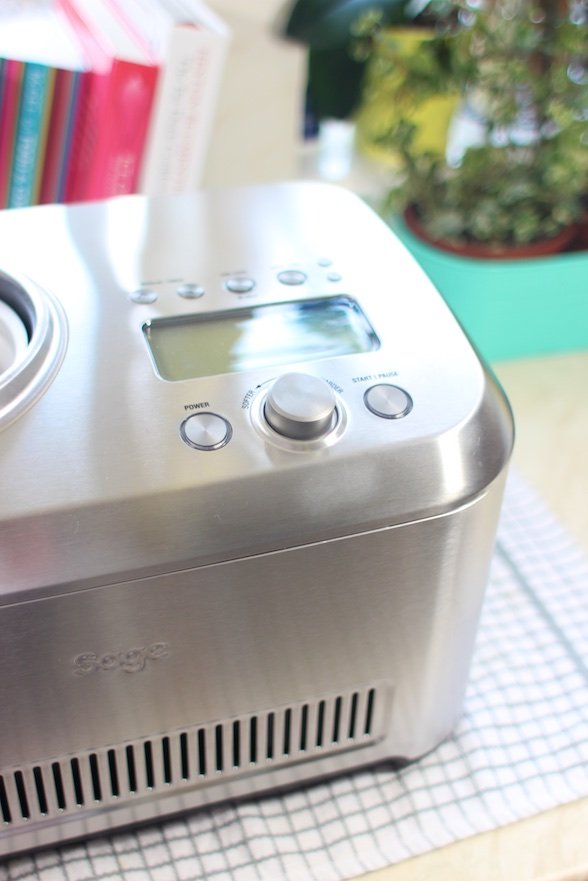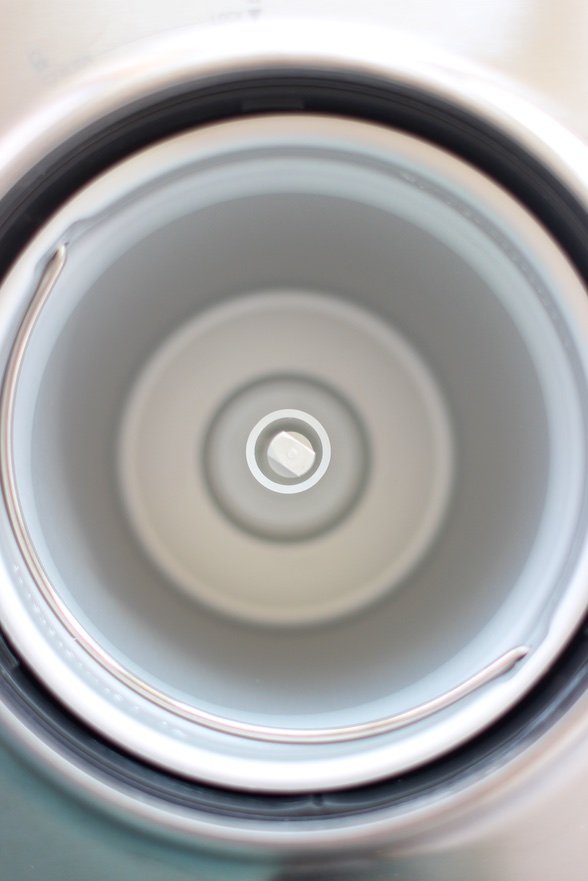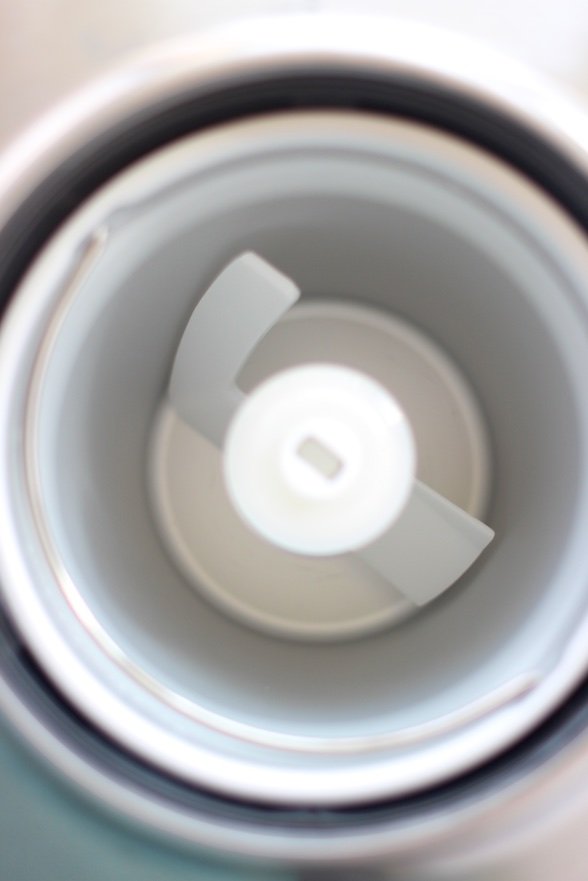Breville BCI600XL Smart Scoop Ice Cream Maker - A Comprehensive Review
24 MINUTE READ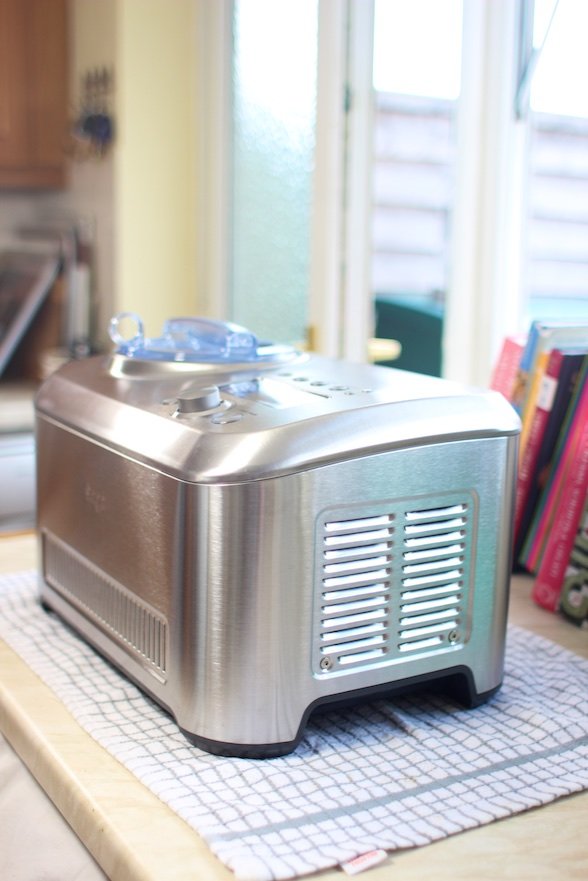 The Breville BCI600XL Smart Scoop Ice Cream Maker, available from amazon*, is a domestic ice cream machine with an in-built freezing system. After a month of testing, I've found that it produces excellent ice cream that is smooth and creamy. It has an optimum capacity of 700 ml (0.74 quart) of mix, producing about 900 ml (0.95 quart) of ice cream with about 29% air in 34 minutes. In a taste test, however, I did find that it produced ice cream that wasn't quite on a par with that produced by either the Cuisinart ICE-100* or the Whynter ICM-200LS*, with these two machines scoring higher for creaminess perception. My only complaint is that the dasher motor isn't powerful enough to produce sufficient torque to continue mixing the ice cream until it has sufficiently hardened.You can view the top selling ice cream machines on amazon by clicking here*.
The Breville BCI600XL Smart Scoop Ice Cream Maker, available from amazon*, is a domestic ice cream machine with an in-built freezing system. After a month of testing, I've found that it produces excellent ice cream that is smooth and creamy. It has an optimum capacity of 700 ml (0.74 quart) of mix, producing about 900 ml (0.95 quart) of ice cream with about 29% air in 34 minutes. In a taste test, however, I did find that it produced ice cream that wasn't quite on a par with that produced by either the Cuisinart ICE-100* or the Whynter ICM-200LS*, with these two machines scoring higher for creaminess perception. My only complaint is that the dasher motor isn't powerful enough to produce sufficient torque to continue mixing the ice cream until it has sufficiently hardened.You can view the top selling ice cream machines on amazon by clicking here*.
You might also like to read:
Cuisinart ICE-100 Ice Cream and Gelato Maker - A Comprehensive ReviewLello 4080 Musso Lussino - A Comprehensive ReviewVanilla Ice Cream - RecipeWhy is corn syrup used in ice cream?The role of fat in ice cream
[toc]
1. My Review Method
I've used a slightly unconventional method of review. Let me explain. The best ice creams in the world have a smooth and creamy texture. This texture, primarily associated with a high milk fat content, is also determined by the average size of the ice crystals: smooth and creamy ice cream requires the majority of ice crystals to be small. If many crystals are large, the ice cream will be perceived as being coarse or icy. Because ice crystal size is a critical factor in the development of smooth texture, I've discussed the key principles that underpin ice crystal formation and growth, and how these principles are affected by the features of the Breville BCI600XL Smart Scoop (known as the Sage by Heston Blumenthal BCI600UK here in the UK). By having an understanding of these key principles, I hope that you'll be in a better position to evaluate this machine.If you're short on time, you can skip to the Summary of this review. If you'd like a nice long read, then sit back, grab yourself a hot cup of cocoa, and the enjoy this comprehensive review; it will take 24 minutes to read. :)
2. Ice Crystals in Ice Cream
Ice crystals range in size from about 1 to over 150 μm in diameter, with an average size of about 25 μm in commercial ice cream ([^1] [^2] [^3] [^4] [^5] [^6]). Small ice crystals, around 10 to 20 µm in size, give ice cream its smooth and creamy texture, whereas larger ice crystals, greater than 50 μm, impart a grainy texture ([^5] [^7] [^8]). To produce ice cream with the smallest possible ice crystals, it’s important to develop an understanding of ice formation (known as crystallisation) during the freezing of ice cream.
Ice cream is frozen in two stages, the first being a dynamic process where the mix is frozen in a scraped-surface freezer (SSF) (an ice cream machine) whilst being agitated by the rotating dasher, a mixing device with sharp scraper blades attached, to incorporate air, destabilise the fat, and form ice crystals. Upon exiting the SSF, the ice cream, at about -5°C to -6°C (23°F to 21.2°F) and with a consistency similar to soft-serve ice cream, undergoes static freezing where it is hardened in a freezer without agitation until the core reaches a specified temperature, usually -18°C (-0.4°F). Cook & Hartel[^9] argue that the dynamic freezing stage is arguably the most important step in creating ice cream because this is the only stage in which ice crystals are formed.
2.1 Nucleation
During dynamic freezing, the ice cream mix is added to the SSF at between 0°C and 4°C (32°F and 39.2°F). As the refrigerant absorbs the heat in the mix, a layer of water freezes to the cold barrel (the bowl in the case of the Breville BCI600XL) wall causing rapid nucleation (the birth of small ice crystals) ([^10]). For smooth and creamy ice cream, it’s important to have a high rate of nucleation so as to form as many small ice crystals as possible ([^3]). The more ice crystals that are formed during dynamic freezing, the more will be preserved during static freezing, resulting in a smaller average crystal size and smoother texture ([^9]).
2.2 Growth and Recrystallisation
The crystals that form at the cold barrel wall are then scraped off by the rotating scraper blades and dispersed into the centre of the barrel, where warmer mix temperatures cause some crystals to melt and others to grow and undergo recrystallisation. Recrystallisation is defined as “any change in number, size, shape… of crystals” ([^11]) and basically involves small crystals disappearing, large crystals growing, and crystals fusing together. The greater the extent of growth and recrystallisation in the centre of the barrel, the larger the ice crystals will be. Russell et al.[^12] found that crystallisation during the freezing of ice cream is dominated by recrystallisation and growth and that these mechanisms appear to be more important than nucleation in determining the final crystal population.
3. Factors Affecting Nucleation, Growth, and Recrystallisation
3.1 The Scraper Blades
Nucleation is affected by the rate of heat transfer from the mix to the cold freezer barrel, with a high rate of heat transfer promoting a high rate of nucleation ([^3] [^13]). Because heat travels more slowly through ice than stainless steel, ice build up on the freezer barrel wall acts as an insulator and lowers the rate of heat transfer.
Keeping the scraper blades sharp and close to the barrel wall helps promote a high rate of heat transfer by scraping off any ice that forms at the barrel wall ([^13]). Ben Lakhdar et al.[^14] found that a large gap between the scraper blades and the barrel wall slowed heat transfer. This was attributed to a permanent ice layer, which forms between the blades and the wall only when the gap is high enough (3mm). When the gap is 1mm, the ice layer is not strong enough and is periodically removed from the wall.
Does the Breville BCI600XL leave a gap between the scraper blades and the bowl wall?
The Breville BCI600XL comes with a plastic dasher that has 2 protruding plastic arms, one longer than the other. These two arms act as scraper blades by scraping off the ice that forms at the bowl wall and dispersing it into the centre. I've found that when fitted onto the central pin inside the bowl, the longer arm leaves a gap of 2mm at its closest point to the wall, increasing to 3mm as it curves away from the wall, and the smaller arm a 3mm gap. This results in a 2mm-3mm layer of ice freezing to the bowl wall, which lowers the rate of heat transfer.
3.2 Air In Ice Cream
The amount of air incorporated into a mix during dynamic freezing (referred to as the overrun) affects the size of the ice crystals, with slightly larger ice crystals observed at a lower overrun ([^15] [^16]). Flores and Goff[^17] suggested that overrun below 50% does not influence ice crystal size, but the amount of air cells at 70% overrun is just enough to prevent collisions among ice crystals, which can result in an increase in crystal size. Sofjan & Hartel[^6] found that increasing the overrun in ice cream (from 80% to 100% or 120%) led to the formation of smaller ice crystals, although the effect was relatively small.
How much air does the Breville BCI600XL whip into ice cream?
Goff & Hartel[^13] note that standard ice cream has between 100 and 120% air (yes, 120% air!), premium between 60 and 90%, and superpremium 25 to 50%. The dasher in the BCI600XL rotates at a relatively low 55 revolutions per minute (rpm), compared to typical speeds of 100-200 rpm in commercial machines, producing 'superpremium' ice cream with about 29% air. The BCI600XL incorporates more air than the Cuisinart ICE-100 (25%) and the Whynter ICM-200LS (10%), resulting in ice cream that is slightly lighter and airier.
Does the Breville BCI600XL make gelato?
Yes, the Breville BCI600XL does make gelato. All domestic ice cream machines are capable of making gelato. Let me explain. Italian-style ice cream is referred to as gelato, the Italian word for ice cream. There are, however, significant differences between traditional gelato and regular ice cream: gelato is typically lower in milk fat (4-8% in gelato, 10-18% in ice cream), total solids (36-43% in gelato, 36->40% in ice cream), and air (20-40% in gelato, 25-120% in ice cream) but higher in sugar (up to 25% in gelato, 14-22% in ice cream) ([^13]). Gelato also tends to be softer, more pliable and stickier than ice cream, and is served at warmer temperatures. Because the Breville BCI600XL incorporates about 29% air into the mix, well within the typical 20-40% range for gelato, as long as you use a good gelato recipe, it will happily produce gelato.
I've tried the Pistachio Gelato recipe in the instruction manual, which you can read here, but sadly haven't been able to get positive results. The recipe yielded 600 ml (0.63 quart) of gelato mix, producing 700 ml (0.74) of extremely coarse and icey gelato with about 17% air in 50 minutes.
3.3 The Freezer Barrel Wall Temperature
Decreasing the temperature at the freezer barrel wall causes higher ice crystal nucleation rates and reduces recrystallisation in the centre of the barrel, which helps ice crystals remain small. ([^8] [^12]). Cook & Hartel[^18] simulated ice cream freezing in an ice cream machine by freezing ice cream mix in a thin layer on a microscope cold stage. The temperature at which the ice cream mix was frozen on the cold stage varied from -7°C, -10°C, -15°C, and -20°C (19°F, 14°F, 5°F, and -4°F). The researchers found that warmer freezing temperatures gave more elongated and slightly larger crystals with a wider size distribution.To promote the formation of smaller ice crystals, the temperature of the refrigerant should fall within the range of -23°C to -29°C (-10°F to -20°F) ([^13]), with the freezer barrel wall temperature estimated to be a few degrees warmer.
How cold does the bowl get?
I've found that the R134A refrigerant in the BCI600XL is able to get the bowl wall temperature down to around -28°C (-18.4°F) when empty. This I achieved by leaving the machine running for 15 minutes before I added the ice cream mix.
How much ice cream does the Breville BCI600XL make?
The Breville BCI600XL has a removable 1.5 quart anodised aluminium freezer bowl. The instruction manual, available by clicking here, states ‘due to aeration of ingredients do not exceed 3½ cups (828 ml or 0.87 quarts) of liquid ingredients.' I've found that although it's able to freeze 800 ml (0.85 quarts) of ice cream mix, producing about 950 ml (1 quart) of ice cream with about 20% air in 30 minutes, the increased load puts more stress on the dasher motor, causing the dasher to stop rotating before before the mix has hardened sufficiently. This results in runny ice cream that isn't as smooth and creamy as when 700 ml (0.85 quart) of mix is frozen. my advice would therefore be to freeze no more than 700 ml (0.85 quart) of ice cream mix for optimum results.
3.4 Draw Temperature
The draw temperature is the temperature at which ice cream is removed from the barrel once dynamic freezing is complete. In commercial machines, this is usually -5°C to -6°C (23°F to 21.2°F) ([^13]). Draw temperature significantly influences mean ice crystal size because it determines how much water is frozen during dynamic freezing and, consequently, how many ice crystals are formed. Decreasing the draw temperature results in more water being frozen and increased ice crystal content ([^19]). The more ice crystals that are formed during dynamic freezing, the more will be preserved during static freezing, resulting in a smaller average crystal size and smoother texture ([^9]).
Drewett & Hartel[^8] showed that ice crystals were larger at draw temperatures from -3°C to -6°C (26.6°F to 21.2°F). When the draw temperatures were colder than -6°C (21.2°F), the mean ice crystal size decreased.
Low Temperature Extrusion
Bolliger[^20] and Windhab et al.[^21] investigated the influence of Low Temperature Extrusion (LTE) freezing of ice cream, where ice cream exiting the SSF at -5°C to -6°C (23°F to 21.2°F) is frozen further to about -13°C to -15°C (8.6°F to 5°F) in an extruder with slowly rotating screws, on the ice crystal size in comparison to conventional draw temperatures. It was shown that the mean ice crystal size was reduced by a factor of 2 by means of the LTE process compared to conventional freezing. Sensorial properties like consistency, melting behaviour, coldness, and scoopability also showed clearly improved values ([^21]).
Besides the ice crystal size, the size and distribution of air cells and fat globules are of primary importance, especially on the sensorial aspect of creaminess. To obtain creamier ice cream, it's important to generate ice crystals, air cells, and fat globule aggregates as small as possible ([^22]). LTE helps to prevent air bubbles from coming together, thereby retaining the smallest size distribution ([^7]). Air Bubbles in the 10-15 μm range have been reported in LTE frozen ice cream, compared to conventionally frozen ice cream samples with bubbles in the 40-70 μm range ([^23]). LTE also helps to reduce the size of agglomerated fat globules compared to conventionally frozen ice cream ([^24] [^25]).
LTE generally promotes enhanced fat destabilisation, which is partially responsible for slow melting and good shape retention ([^23]). Fat destabilisation in LTE treated ice cream can be twice that achieved during the conventional freezing process ([^26]). Because of smaller air bubbles and fat globule aggregates, as well as a higher degree of fat destabilisation, LTE ice cream is evaluated creamier than conventionally produced ice cream ([^22]).
How do you know when the ice cream is done?
In line with the beneficial effects of LTE freezing on ice cream texture reported above, I've found that ice cream extracted from domestic ice cream machines at draw temperatures of -10°C (14°F) or lower is perceived smoother and creamier than that extracted at conventional draw temperatures of around -6°C (21.2°F). To measure draw temperature, I use a cheap infra-red thermometer*.
The one complaint I have about the Breville BCI600XL is that the dasher motor isn't able to produce sufficient torque to continue agitating the mix to a draw temperature of -10°C (14°F). When the ice cream reaches -9°C (15.8°F), the hardened ice cream causes the dasher to stop rotating, resulting in a decreased ice crystal content and, ultimately, larger ice crystals.
12 hardness settings
Residence time, which refers to the length of time ice cream spends in the barrel and takes to reach its draw temperature, has a significant effect on the final ice crystal size distribution, with shorter residence times producing ice creams with smaller ice crystals due to a decline in recrystallisation ([^4] [^8] [^9] [^12] [^13]). Longer residence times mean that ice cream spends more time in the bulk zone of the barrel where warmer temperatures cause rapid recrystallisation. Donhowe & Hartel[^1] measured a recrystallisation rate at -5°C (23°F) of 42 μm/day. At this rate, a size increase of around 8 μm would be expected over a 10 minute period. This matches almost exactly the increase in crystal size observed by Russell et al.[^12] at a slightly different temperature of -4°C (24.8°F).
A high rate of heat transfer and colder barrel wall temperatures contribute significantly to shorter residence times. Lower barrel wall temperatures lower the bulk temperature of the ice cream faster, reducing residence time and improving the ice crystal size distribution ([^8] [^12]). Investigating the effect of draw temperature, dasher speed, and residence time on ice crystal size, Drewett & Hartel[^8] concluded that residence time had the greatest impact on final crystal size distribution, followed by drawing temperature and dasher speed.
How long does it take to freeze a batch of ice cream?
I've found that it takes 34 minutes to freeze 700 ml (0.74 quart) of ice cream mix to a draw temperature of -9°C (15.8°F). This compares to 25 minutes for 800 ml (0.85 quart) of ice cream mix to be frozen to a draw temperature of -10°C (14°F) in the Cuisinart ICE-100, and 27 minutes for 1000 ml (1.06 quart) of ice cream mix to be frozen to a draw temperature of -10°C (14°F) in the Whynter ICM-200LS.
TIP #1
Switch the compressor on and leave it running for 15-20 minutes before you add your mix. This will ensure that the barrel is as cold as possible when the mix is added, which will promote higher rates of nucleation, reduce recrystallisation, and reduce the residence time. I've found that the residence time increases by 1 minute and 45 seconds when I don't pre-freeze the barrel for 20 minutes before adding my mix. You can use the 'Pre Cool' setting on the BCI600XL for this.
4. Does the Breville BCI600XL Make Good Ice Cream?
Yes I've found that the BCI600XL does make smooth and creamy ice cream that is comparable to gelato or 'superpremium' ice cream. I get consistently smooth and creamy results with my own recipe, an example of which you can see in my Vanilla Ice Cream Recipe, and have also gotten good results with the basic vanilla ice cream recipe in the instruction manual, which you can read here.
How does the Breville BCI600XL compare to the Cuisinart ICE-100 and the Whynter ICM-200LS?
In a taste test to compare the texture of ice cream produced by the BCI600XL to that produced by the Cuisinart ICE-100* and the Whynter ICM-200LS*, I found that although the BCI600XL produced smooth and creamy ice cream, it wasn't quite on a par with that produced by the other two machines: both the ICE-100 and the ICM-200LS produced ice cream that was denser and perceived to be creamier, with the ICE-100 scoring the highest for creaminess perception.
5. General Questions
What are the dimensions, Weight, and Voltage?
The BCI600XL comes in an impressive stainless steel finish. It's a relatively small machine, weighing 14.5 kg (32 pounds) and measuring 41 cm (16.2") in length, 26.7 cm (10.5") in width, and 26 cm (10.2") in height. I've found it very easy to move from the bottom shelf of my stainless steel table, where it's stored, and onto the table top for use. Here in the UK, it runs on 230v 50Hz and operates at 148 watts (+/- 10 watts) when empty and up to 288 watts when full. In the US, it's 110/120v 60Hz.
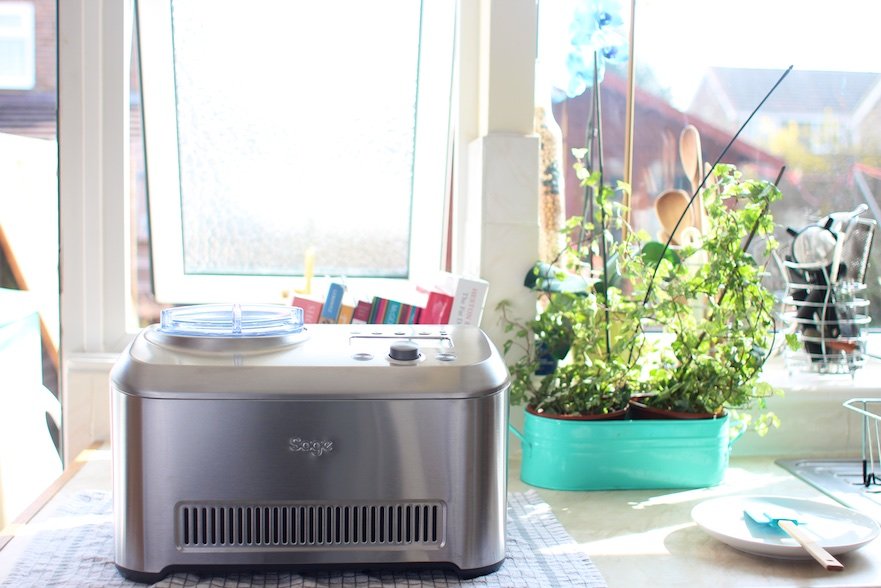
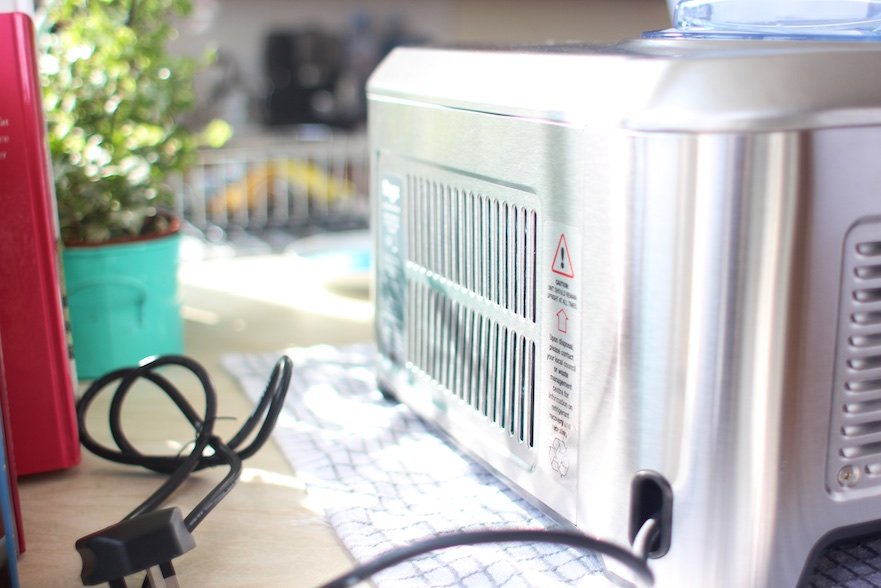
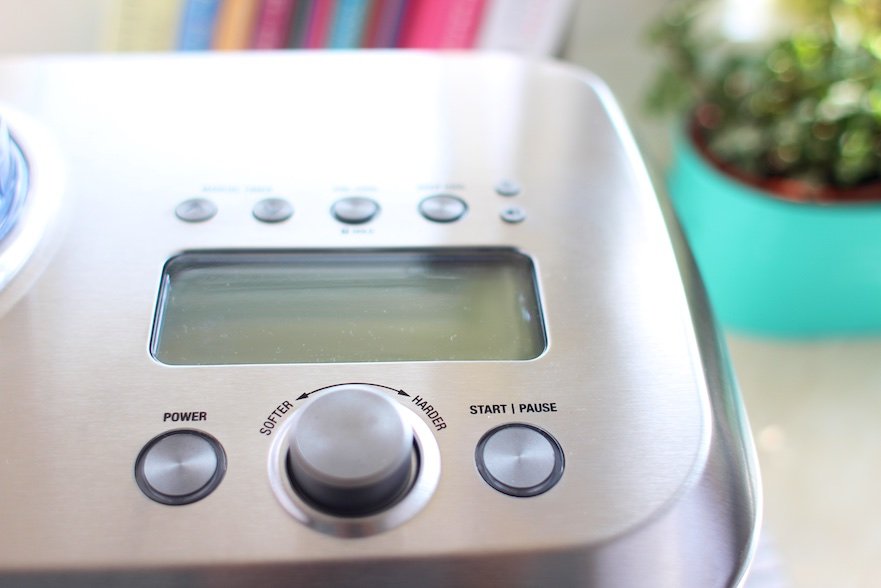 Is it Noisy?
Is it Noisy?
No not at all. I've found it very quiet during freezing and haven't had any problems sitting in the same room with it on. It produces about 73 dB of noise during freezing, measured from about 15 cm (5.9") from the front of the machine. I haven't had any problems with the dasher squeaking as it rotates, or the drive mechanism making grinding noises.
Is it easy to clean?
Yes the removable 1.5 quart anodised aluminium freezer bowl is very easy to clean with some warm soapy water; it's not dishwasher safe. Cleaning the bowl and dasher takes me no more than a few minutes.
What is the Warranty?
Here in the UK, the BCI600XL has a 2-year manufacturers' warranty, whilst you guys in the US only seem to get a 1-year warranty. This is shorter than the 5-year manufacturers' warranty we get here in the UK, 3-year warranty in the US, with the Cuisinart ICE-100.
6. My only complaint
As I've previously mentioned, my only complaint is that the dasher motor isn't able to produce sufficient torque to continue agitating the mix to a draw temperature of -10°C (14°F), the optimum draw temperature I've found for homemade ice cream. When the ice cream reaches -9°C (15.8°F), the hardened ice cream causes the dasher to stop rotating, resulting in less water being frozen, a decreased ice crystal content, and, ultimately, larger ice crystals. Both the Cuisinart ICE-100 and the Whynter ICM-200LS are able to continue agitating ice cream to a draw temperature of -10°C (14°F).
Some reviewers on amazon have noted a loud grinding noise, similar to gears grinding in a car’s transmission, and a plastic/electrical smell coming from the machine. I haven't experienced either of these problems with my BCI600XL but my guess is that both are a result of too much stress being placed on the relatively weak dasher motor.
7. Summary
In the one month that I've been testing this machine, I've found that the the Breville BCI600XL, available from amazon*, produces excellent ice cream that is smooth and creamy. It has an optimum capacity of 700 ml (0.74 quart) of ice cream mix, producing about 900 ml (0.95 quart) of ice cream with about 29% air in 34 minutes, is quiet, easy to move, and easy to clean. My only complaint is that the dasher motor isn't powerful enough to produce sufficient torque to continue agitating the mix to an optimum draw temperature of -10°C (14°F). Instead, the dasher stops rotating when the ice cream reaches -9°C (15.8°F), resulting in less water being froze, fewer ice crystals, and, ultimately, the formation of larger ice crystals. I also found the gelato and ice cream auto settings redundant.
Although the BCI600XL does produce smooth and creamy ice cream, I did find that it wasn't quite on a par with the ice cream produced by the Cuisinart ICE-100* and the Whynter ICM-200LS* when compared in a taste test: these two machines produced ice cream that was denser, chewier, and perceived to be creamier. If I had to recommend one of the three, it would be the Cuisinart ICE-100 simply because it was rated the highest in my taste test.
8. What The * Means
Transparency is key. On that note, I haven't been paid to write this review, nor was I given this machine for free. I paid for this bad boy with my own money and have written this review in my own time. If there is a * after a link, it means that I will earn a payment if you go through it and make a purchase on amazon. This doesn't increase the cost of what you purchase, nor do these links influence what I write, ever.
9. References
[^1]: Donhowe, D. P., and Hartel, R. W., 1996. Recrystallization of ice during bulk storage of ice cream. Int Dairy J. 6(11–12):1209–21.
[^2]: Hagiwara, T., and Hartel, R. W. 1996. Effect of sweetener, stabilizer, and storage temperature on ice recrystallization in ice cream. J Dairy Sci. 79(5):735–44.
[^3]: Hartel, R. W., 1996. Ice crystallisation during the manufacture of ice cream. Trends in Food Science & Technology. 7(10).
[^4]: Koxholt, M., Eisenmann, B., and Hinrichs, J., 2000. Effect of process parameters on the structure of ice cream. Bur Dairy Mag. 1:27-30.
[^5]: Marshall, R. T., Goff, H. D., and Hartel R. W., 2003. Ice cream (6th ed). New York: Kluwer Academic/Plenum Publishers.
[^6]: Sofjan, R., P., and Hartel, R. W., 2004. Effects of overrun on structural and physical characteristics of ice cream. International Dairy Journal. 14, 255-262.
[^7]: Eisner, M. D., Wildmoser, H., and Windhab, E. J., 2005. Air cell microstructuring in a high-viscous ice cream matrix. Colloids Surf A. 263(1–3). 390–9.
[^8]: Drewett, E. M., and Hartel, R. W., 2007. Ice crystallisation in a scraped surface freezer. Journal of Food Engineering. 78(3).
[^9]: Cook, K. L. K., and Hartel, R. W., 2010. Mechanisms of Ice Crystallisation in Ice Cream Production. Comprehensive Reviews in Food Science and Food Safety. 9(2).
[^10]: Hartel, R. W., 2001. Crystallisation in foods. Gaithersburg, MD: Aspen Publishers.
[^11]: Fennema, O. R., Powrie, W. D., Marth, E. H., 1973. Low Temperature Preservation of Foods and living Matter. USA: Marcel Dekker, Inc.
[^12]: Russell, A. B., Cheney, P. E., and Wantling, S. D., 1999. Influence of freezing conditions on ice crystallisation in ice cream. Journal of Food Engineering. 29.
[^13]: Goff, H. D., and Hartel R. W., 2013. Ice Cream. Seventh Edition. New York Springer.
[^14]: Ben Lakhdar, M., Cerecero, R., Alvarez, G., Guilpart, J., Flick, D., and Lallemand, A., 2005. Heat transfer with freezing in a scraped surface heat exchanger. Applied Thermal Engineering. 25(1), 45–60.
[^15]: Arbuckle, W. S., 1977. Ice cream (3rd ed.). Connecticut: Avi Publisher Company.[^16]: Flores, A. A., and Goff, H. D., 1999. Recrystallization in ice cream after constant and cycling temperature storage conditions as affected by stabilizers. Journal of Dairy Science. 82, 1408–1415.
[^17]: Flores, A. A., and Goff, H. D., 1999. Ice crystal size distributions in dynamically frozen model solutions and ice cream as affected by stabilizers. Journal of Dairy Science. 82. 1399–1407.
[^18]: Cook, K. L. K., and Hartel, R. W., 2011. Effect of freezing temperature and warming rate on dendrite break-up when freezing ice cream mix. International Dairy Journal. 21(6).
[^19]: Caillet, A., Cogne, C., Andrieu, J., Laurent, P., and Rivoire, A., 2003. Characterization of ice cream structure by direct optical microscopy. Influence of freezing parameters. Lebensm Wiss U Technol. 36:743–749.
[^20]: Bolliger, S., 1996. Freeze structuring in food systems under mechanical energy input. Dissertation no. 11914, Department of Food Science, ETH, ZuK rich, Switzerland.
[^21]: Windhab, E. J., Wildmoser, H. et al., 2001. Production en continu de crème glacée, Revue Genèrale Du FROID, 1011. 49-54.
[^22]: Wildmoser, H., Scheiwiller, J., and Windhab, E. J., 2004. Impact of disperse microstructure on rheology and quality aspects of ice cream. Food Sci. Technol. 37:881–891.
[^23]: Bolliger, S., Kornbrust, B., Goff, H. D., Tharp, B. W., and Windhab, E. J., 2000. Influence of emulsifiers on ice cream produced by conventional freezing and low-temperature extrusion processing. Int. Dairy J. 10:497–504.
[^24]: Windhab, E., and Bolliger, S., 1998. Low temperature ice-cream extrusion technology and related ice cream properties. European Dairy Magazine, 10, p.24-28.
[^25]: Windhab, E. J., and Bolliger, S., 1998. New developments in ice-cream freezing technology and related on-line measuring techniques. In W. Buchheim, Ice cream (p. 112-130). Special Issue 9803, Brussels, Belgium: International Dairy Federation.
[^26]: Soukoulis, C., and Fisk, I., 2016. Innovative Ingredients and Emerging Technologies for Controlling Ice Recrystallization, Texture, and Structure Stability in Frozen Dairy Desserts: A Review, Critical Reviews in Food Science and Nutrition, 56:15, 2543-2559.

